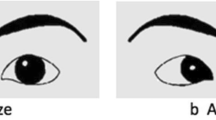Abstract
Fifteen experienced psychiatrists rated gaze and gaze avoidance, presented without sound from videotaped recordings of a standardized interview with schizophrenic, depressed and anxious patients. These psychiatrists then derived symptoms and diagnoses from the written transcript of interview and the two classes of rating were compared. Gaze, as perceived by these experienced psychiatrists was different in the three patient groups but the differences were more closely related to symptoms than to diagnoses and “affective” symptoms correlated more closely with gaze than did cognitive symptoms.
Similar content being viewed by others
References
Argyle, M.Social Interaction. London: Methuen & Co., 1969.
Argyle, M. & Cook, M.Gaze and mutual gaze. Cambridge: University Press, 1976.
Argyle, M. & Dean, R. Eye contact, distance and affiliation.Sociometry, 1965,28, 289–304.
Argyle, M. & Ingham, R. Gaze, mutual gaze and proximity.Semiotica, 1972,6, 32–49.
Bate, B. Effects of various social reinforcers on interviewee eye contact.Dissertation Abstracts International, 1972,32(12-B, 7268.
Condon, W. & Ogston, W. Sound film analysis of normal and pathological behavior patterns.Journal of Nervous and Mental Disease, 1966,143, 338–347.
Cook, M. Experiments on orientation and proxemics.Human Relations, 1970,23, 61–76.
C.S.I.R.O. Personal communication, 1978.
Ellsworth, P. & Ludwig, L. Visual behaviour in social interaction.Journal of Communication 1972,22, 375–403.
Exline, R. Visual interaction: The glances of power and preference.Nebraska Symposium on Motivation. J. Cole (ed.). Lincoln: University of Nebraska Press, 1972.
Exline, R. & Winters, L. Affective relations and mutual glances in dyads. S. Tomkins & C. Izard.Affect, cognition and personality. New York: Springer, 1965.
Harris, S. Schizophrenic's mutual glance patterns.Dissertation Abstracts International 1968,29(6-B, 2202.
Hinchcliffe, M., Lancashire, M. & Roberts, F. Eye contact and depression: A preliminary report.British Journal of Psychiatry, 1970,117, 571–572.
Jones, I.H. & Pansa, M. Some nonverbal aspects of depression and schizophrenia occurring during interview.Journal of Nervous and Mental Disease, 1979.
Kendon, A. & Cook, M. The consistency of gaze patterns in social interaction.British Journal of Psychology, 1969,60, 481–494.
Lefcourt, H. Visual interaction and performance of process and reactive schizophrenics as a function of experimenter's sex.Journal of Personality, 1967,35, 535–546.
Libby, W. Eye contact and direction of looking as stable individual differences.Journal of Experimental Research in Personality, 1970,4, 303–312.
Libby, W. & Yaklevitch, D. Personality determinants of eye contact and direction of gaze aversion.Journal of Personality and Social Psychology, 1973,27, 197–206.
McBride, G., King, M. & James, M. Social proximity effects on galvanic skin responses in adult humans.Journal of Psychology, 1965,61, 153–157.
Mehrabian, A.Nonverbal communication. Chicago: Aldine Atherton, 1972.
Modigliani, A. Embarrassment, facework and eye contact: towards a theory of embarrassment.Journal of Personality and Social Psychology, 1971,71, 15–24.
Riemer, M. Abnormalities of gaze: a classification.Psychiatric Quarterly, 1955,29, 659–672.
Rosenfield, H. The experimental analysis of interpersonal influence process.Journal of Communication, 1972,22, 424–442.
Russo, N. Eye contact, interpersonal distance and the equilibrium theory.Journal of Personality and Social Psychology. 1975,31, 497–502.
Rutter, D. Visual interaction and speech patterning in remitted and acute schizophrenic patients.British Journal of Social and Clinical Psychology, 1977,16, 357–361.
Rutter, D. & Stephenson, G. Visual interaction in a group of schizophrenic and depressed patients.British Journal of Social and Clinical Psychology, 1972,11, 57–65.
Siegel, S.Non parametric statistics for the behavioural science. Tokyo: McGraw-Hill Kogukusha, 1956.
Stephenson, G., Rutter, D. & Dore, S. Visual interaction and distance.British Journal of Psychiatry, 1973,64, 251–257.
Von Cranach, M., Frenz, H. & Frey, S. Die “angenehmste Entfernung” zur Betrachtung socialer Objekte.Psychologishe Forschung, 1968,32, 89–103.
Waxer, P. Nonverbal cues for depression.Journal of Abnormal Psychology, 1974,83, 319–322.
Waxer, P. Nonverbal cues for depth of depression: set versus no set.Journal of Consulting and Clinical Psychology, 1976,44, 493.
Author information
Authors and Affiliations
Rights and permissions
About this article
Cite this article
Pansa-Henderson, M., Jones, I.H. Gaze and gaze avoidance as perceived by psychiatrists during clinical interviews with schizophrenic, depressed, and anxious patients. J Nonverbal Behav 7, 69–78 (1982). https://doi.org/10.1007/BF00986869
Issue Date:
DOI: https://doi.org/10.1007/BF00986869




